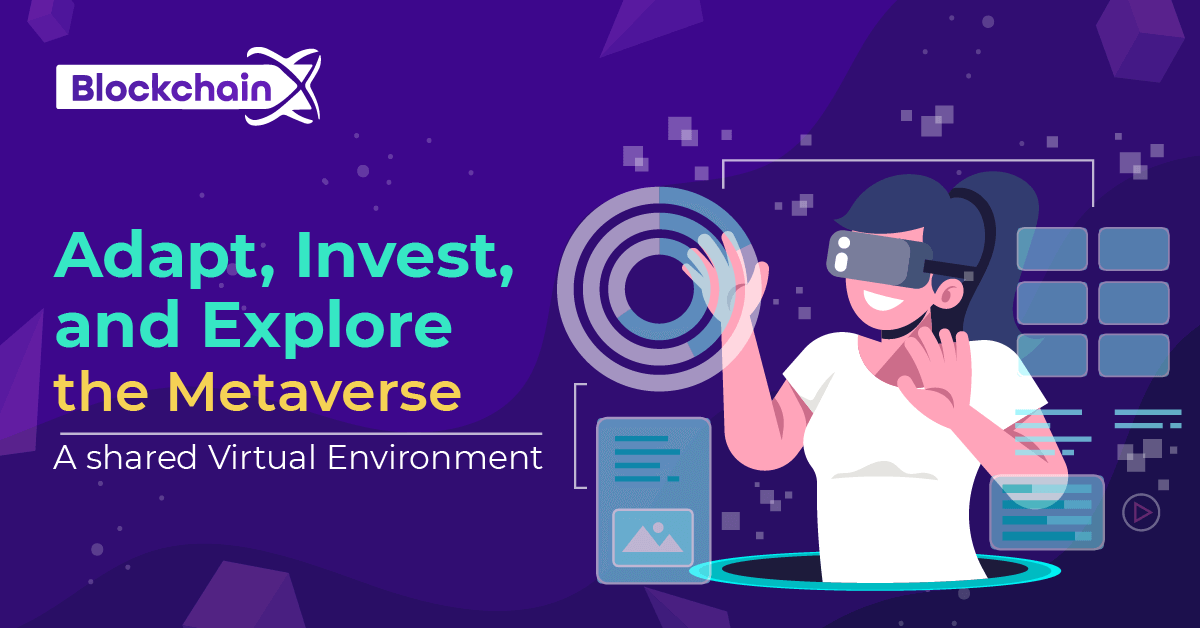What can become reality? The Metaverse : A shared Virtual Environment
The Metaverse is undoubtedly a fancy word, but it includes much more. Get ready for a world of lights and noises, a reality that is different from your present one, and an internet future. The Metaverse is a form of the Internet that we may literally enter rather than just view and utilise. It will truly change the direction we live. his technology's potential has been acknowledged and embraced. Facebook changed its name to Meta last year, indicating the social network's intention to lead the way in the modern world. Morever, interest in the project is still rising.
Technology hype cycles come and go. Before it is realised, the Metaverse may burn out. That doesn't appear to be the situation right now, though. It is now a widely used term in NFTs, gaming, and retail. Let's start with a deep dive into the Metaverse and the virtual environment of metaverse .
What is Metaverse?
A public virtual environment that is accessible through the internet is the Metaverse. It can be referred to as a "virtual world" having arees like offices, homes, parks, parties, and clubs that parallel our real-world lives and activities. People can communicate digitall space convergence of social networking through augmented reality (AR), virtual reality (VR), and crypto. Moreover, users can explore the Metaverse at their leisure without any particular purpose by assuming a virtual reality headset and using controllers.
In the Metaverse, digital currency is used, among other things, for the purchase of clothing, weapons, and shields. Additionally, for Metaverse historical events like music concerts and live events, tickets are distributed to the appropriate audiences through the NFT ticketing system. The world really does exist in this dream! Let's go back to the journey, and see how this creative idea came to be.
Metaverse and Cryptocurrencies
Spending virtual currency in a virtual environment! Cryptocurrency and the metaverse appear to go hand in hand in Cryptocurrency and the metaverse appear to go hand in hand.both concepts as essential components of WEB 3.0, the third-generation internet. Users of cryptocurrencies will get more at ease with its methods of acquisition, handling, and storage as it replaces traditional currencies as the primary means of exchange for people trading and purchasing in the metaverse.
Cryptocurrencies serve a similar role to real money in the world economy through trade and finance in supporting metaverse and metaverse economic development and innovation. In those virtual worlds, people will use it for paying, shopping, and trading.
Key Features of Crypto Metaverses
The most appealing option seems to be a potent blend of crypto and metaverse, so let's explore some intriguing possibilities.
Financialization is the first notion that comes to mind in reference to this transaction. Crypto helps finance assets in a number of different ways, including identity, digital ownership, and trade.
Identity
In a similar way to how decentralised cryptocurrency wallets are linked to public addresses, user identities will be associated with public addresses. Your cryptocurrency wallets can be used to store more than just tokens; they can also be used to store digital goods like avatars, clothes, accessories, and weapons. You can use them in other interconnected metaverses or retain them in your wallet as a store of value.
Trading
In the metaverse, cryptocurrencies are a great way to trade value. The ability to buy and sell assets is enabled by combining the stability of currency with the borderless nature of cryptocurrencies. The selling of virtual lands and properties would be encouraged by existing crypto markets, especially cross-chain markets.
Digital Ownership
Everyone should be aware that the idea of digital ownership is changing as a result of NFTs. Users can gain immutable, publicly verifiable rights to use metaverse assets as NFTs, allowing them to trade in markets.
How does the Metaverse work?
Most people don't know how quickly technology has advanced, yet it will be important in the Metaverse.It will only be necessary to use digital workstations for Metaverse work, and 3D avatars can meet "face to face" without the need for conference equipment. With the use of blockchain technology and digital assets, it aspires to become an open ecosystem in which anybody with access to the internet may take part.
It is planned to be a public blockchain that uses its own digital currency, ETP, to create a "internet of value" by offering a decentralised and immutable record. ETP is an ERC20 token that can be used as a medium of exchange in the Metaverse. The ETP token can be used to make payments if other cryptocurrencies are supported. Additionally, it can be used as collateral for loans made on the website.
What can you buy on Metaverse?
Shopping in Metaverse may be enjoyable as well. Virtual real estate is available for purchase and sale. In the metaverse, you may use cryptocurrencies, mostly Ethereum, to buy plots. For instance, when you buy a piece of land, the transfer of NFT registers the sale and transfer of ownership. The transfer will take a few seconds as it checks whether your digital wallet has enough money to buy the property. After that, you will be notified that you are the property's new legal owner in the virtual world.
In addition ,you can purchase a car dealership and shop for items like digital instruments, clothing, jewellery, food, shoes, ART, and other things.
What can you do in the Metaverse?
Purchase and profit from real estate.
Meet and collaborate with distant co workers socializing and making new friends.
Attend performances, trade exhibits, and educational events.
Play games in virtual reality.
Sell game assets into cryptocurrency tokens.
Purchase digital art from NFTs.
It may sound absurd, but weddings might potentially be held in a Metaverse virtual location. On the cloud, couples can invite guests to their wedding who wouldn't fit in a traditional venue.
Metaverse Historical Events: Timeline
2021
Facebook changed its name to Meta in 2021 to emphasise its commitment to influencing the metaverse's future. Two companies also introduced highly portable virtual reality headsets (HTC's Vive Flow) and smart glasses (Ray-Ban Stories). Microsoft also announced Mesh, a technology designed for virtual teamwork across various platforms.
2020
Apple added Lidar (Light Detection and Ranging) to the iPhone and iPad, enhancing depth perception for better pictures and augmented reality, and paving the way for future mixed-reality headsets.
2009
The first cryptocurrency, Bitcoin, appeared in 2009 and "transformed how we think about money." The cryptocurrency was created by Satoshi Nakamoto as a peer-to-peer payment system that could transfer money without depending on a central organisation to manage and run the network.
2003
Second Life was introduced in 2003. A "three-dimensional (3D) immersive environment that promotes high levels of social networking and information engagement" is what Second Life is described as. The first expansive metaverse-style environment could be Second Life.
Future of Metaverse
The Metaverse is no longer impossible and seems to have a bright future. There's a chance that many of the things we do in the real world will end up happening in the future of Metaverse.
Exploring new developments in augmented reality, virtual reality, and augmented reality, Softweb Solutions is always on the cutting edge.On the other hand, the Metaverse works to remain true to its potential. As a result, in order to go on to the next stage of their growth, Metaverse players will need to confront three frontiers.
securing talented talent, making wise financial decisions, and expanding the realm of creative experiences.
Ultimately
In practical terms, one of the core technologies for creating the metaverse is virtual reality. Users can access the metaverse and virtual reality. On its own, it can only perform a certain set of tasks.
On the other hand, it is a huge and gradually growing virtual environment of metaverse that would contain a 3D representation of the internet. Users can navigate around virtual 3D places in the metaverse, much like they can browse through various online pages. Most grandly, there is no rule on how innovation can be introduced into the metaverse. Learn more about the metaverse and how the virtual environment supports it.

